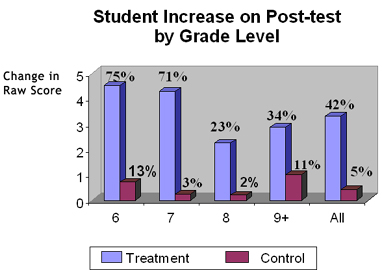
Research-based
HELP has been extensively field-tested and evaluated since the project’s onset five years ago. In an initial pilot, HELP
Numbers Make Sense lessons were tested by an independent researcher (Dr. Tran) with funding from the Colorado Department of Education. The tests used a randomized pre-post, two-group (treatment, control) design. The results of the evaluation (white paper available) clearly demonstrate that HELP is an effective tool in increasing ELLs’ math ability.
Research shows that students’ quick mastery of the program contributes to
increased self-esteem and an increase in perceived ability to learn math. Teachers observed that
HELP lessons captured their students’ attention (students stay on task for about 30 minutes per sitting). Teachers also liked that the program was easy to use and believed that it can increase their ability to provide individualized instruction to their students.
The HELP program was awarded a large multi-year U.S. Department of Education grant to further research and develop the program. University of Colorado research uses an experimental model involving approximately 1,000 students across five states: Texas, California, New York, Oregon and Colorado. Student achievement on the end-of-modules quizzes has been high (in some cases in excess of 300%) and teacher feedback on the program and training (from surveys and focus groups) has been extremely positive, confirming the findings of the initial research.
Research teachers and administrators cite these primary benefits:
- Students are frequently “glued to the computer & don’t want to leave at the end of class.”
- Computer-based sheltered instruction promotes consistent delivery of math content.
- The teacher does not need to be a qualified math teacher or SIOP trained.
- A non-threatening environment where ELLs feel “safe emotionally to practice & learn.”
|
|
|



